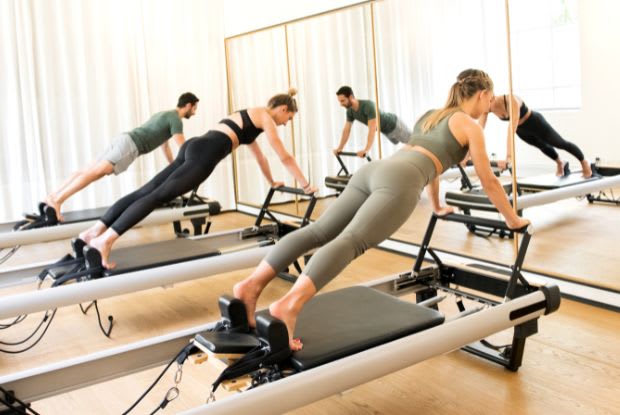The Best Exercises to Lose Belly Fat
The Best Exercises to Lose Belly Fat
Table of Contents
I. Which Exercises Burn Belly Fat?
V. How to Lose Belly Fat by Increasing Your NEAT
Are you one of the many people on a fitness journey wondering how to burn belly fat? Not only is excess belly fat a cosmetic concern, but it also poses serious health risks. Studies have shown that abdominal fat is linked to a higher risk of heart disease, diabetes, and even cancer. 1
Although spot reduction of fat is not possible, shedding overall body weight can help reduce belly fat. In this article, we will discuss which types of exercises you should incorporate into your fitness routine to help you lose belly fat and achieve your weight loss goals.
Which Exercises Burn Belly Fat?
If you are wondering how to lose belly fat, the most important thing is to develop an exercise routine you can stick with long-term. There is no single workout or diet that will specifically target belly fat. However, a combination of aerobic exercise and strength training can help you lose fat overall, including belly fat.
- Aerobic exercise, like cardio workouts, can help burn belly fat because these types of workouts tend to burn more calories than strength training alone. Aim for 150 to 300 minutes of moderate exercise per week, such as brisk walking or light jogging, or 75 to 150 minutes of vigorous exercise, like running or swimming.
- Strength or resistance training is also key because it builds muscle and boosts your resting metabolism, which means you burn more calories even when you're not active. Try to do strength training at least twice a week, incorporating exercises like lunges, squats, pushups, and rows that work your core and major muscle groups. 2
The bottom line is that the "best" workout for losing belly fat is one that you stick with consistently. Start with just three days a week of exercise if you're currently inactive and build up to five days a week over time as you get into better shape. The combination of aerobic and strength training, along with a balanced diet, can help you lose fat all over, including belly fat.
HIIT Workouts

If your goal is to shed belly fat, the best approach is to lower your overall body fat percentage. To accomplish this, you need to burn more calories than you consume each day, creating a calorie deficit. 3
While all exercise helps create a calorie deficit, high intensity interval training (HIIT) is an efficient option. Studies show that HIIT and aerobic exercise, such as running, can both reduce body fat, but HIIT requires less time. 4
HIIT involves alternating between short bursts of intense exercise that spike your heart rate to 80% of its maximum, followed by short recovery periods of lower intensity movement. In just 30 minutes, HIIT provides a complete workout that incorporates both aerobic exercise and strength training. 3
If you are new to HIIT, start with a cardio machine like the treadmill. An example HIIT treadmill workout could be:
- Sprint as fast as you can for 10 seconds
- Walk for 50 seconds
- Repeat for a total of 6 intervals 3
In a review of 13 studies of overweight adults ages 18 to 45, researchers found that HIIT and moderate aerobic exercise yielded similar improvements in body composition. However, HIIT required 40% less workout time. 4
Resistance Training
Strength training, also called resistance training or weight training, is an effective way to lose weight because it builds muscle mass, which boosts your metabolism. When you lift weights or do resistance exercises, you challenge your fast twitch muscle fibers, which control muscle power and force. 5 This results in improvements to your:
- Muscle strength
- Muscle size
- Endurance 5
Strength training contributes to overall body fat loss in the following ways:
- As your muscle mass grows, so does your resting metabolism since your metabolism is largely determined by your fat-free mass, which is mostly muscle. Building muscle mass translates to burning more calories, even when you're not working out.
- After an intense strength training session, you will also benefit from a metabolism-boosting effect called excess post-exercise oxygen consumption (EPOC). During EPOC, your body uses extra energy to recover and repair itself after exercise, resulting in additional calorie burn. 5
Research supports the effectiveness of resistance training for fat loss. A 2021 study in Sports Medicine evaluated 58 studies on resistance training and body fat. Participants performed weight training for at least four weeks. 6 On average, resistance training decreased:
- Body fat percentage by 1.46%
- Body fat mass by 1.2 pounds 6
The researchers concluded that resistance training reduces body fat percentage, mass, and visceral fat in healthy adults. 6
Pilates

Pilates is an exercise technique that was created by Joseph Pilates, an athlete and physical trainer, in the early 1900s. It uses roughly 50 exercises to work the muscles, enhance endurance, and improve balance, posture, and flexibility. 7 Though spot reduction is not possible, pilates can assist with belly fat loss when paired with a healthy diet in a few ways:
- Improves overall fitness: A 2019 study published in PeerJ found that overweight and obese participants who did three one-hour Pilates sessions per week improved their lean and fat mass, trunk endurance, and flexibility. This enhanced fitness can help you perform strength-based exercises more effectively. 8
- Decreased body fat: A meta-analysis of 11 randomized control trials focused on overweight and obese adults concluded pilates reduced body weight and fat, but not waist size. 9
- Better posture: Pilates strengthens smaller stabilizing muscles and the core. Better posture and flexibility from these stronger muscles can make you look slimmer and taller while decreasing injury risk. 7
- Increased muscle mass: Building muscle with pilates can also help burn more calories and lose weight since muscle burns more calories than fat. 7
While pilates incorporates strength and flexibility exercises like other resistance training, it has unique aspects:
- Pilates emphasizes breathwork and mind-body connection, with attention to movement stemming from the core. Exercises repeat in sets to strategically work muscles without overexertion.
- Many pilates workouts also use special spring-based resistance equipment, especially the “reformer” — a sliding platform bed connected to springs, ropes, and pulleys that supports the spine and targets muscles. 7
However, pilates alone lacks enough resistance to be a standalone strength workout. To effectively burn fat, pilates should combine with strength training and cardio. Pilates can act as a base for beginners to build core stability before progressing to higher intensity strength training. 7
How to Lose Belly Fat by Increasing Your NEAT
If you want to shed pounds and reduce belly fat, your daily habits matter. Non-exercise activity thermogenesis (NEAT) describes calories burned from regular daily movement outside of dedicated exercise. NEAT activities like walking, gardening, and household chores can significantly impact weight loss when combined with a healthy diet. 10
Increasing NEAT can help reduce belly fat and overall body weight by sustaining lipoprotein lipase (LPL) levels. LPL is an enzyme that converts fat into energy. 10 Your daily activity can alter the levels of LPL in your body:
- Prolonged periods of inactivity can lower LPL levels, hindering your body's ability to efficiently burn fat.
- By incorporating NEAT into your day and staying consistently active, you can help maintain optimal LPL levels and support your body's fat-burning capabilities. 10
When trying to trim belly fat, NEAT is a key piece of the puzzle. Losing one pound requires burning about 3,500 calories. This can be done by:
- Adding 200 extra calories of NEAT per day (equivalent to a 2-mile walk)
- Cutting 300 calories via healthier eating 10
These choices can lead to a 500 calorie per day deficit. Maintain this deficit for a week and you can lose up to one pound. 10
Conclusion
While you cannot spot reduce belly fat, reducing your overall body weight through diet and exercise can help shrink your waistline over time. The key is to find an exercise routine you can stick to long-term that incorporates both cardio and strength training. What matters most is that you are consistent.
However, if you have been exercising consistently and eating well but still aren't seeing results, talk to your doctor. They may recommend adding a weight loss medication to complement your lifestyle efforts.
Just remember, there is no quick fix—losing belly fat takes time and dedication. ScriptsMD offers an entire weight loss health journal to help you tackle the areas of your life that are holding you back from your weight goals. With ample knowledge, dedication, and the right lifestyle choices, anyone can work towards a healthier self.
References
- Johns Hopkins Medicine 8 ways to lose belly fat and live a healthier life
- WHO Physical activity
- Harvard School of Public Health HIIT (high intensity interval training)
- Wewege, M., van den Berg, R., Ward, R. E., & Keech, A. The effects of high-intensity interval training vs. moderate-intensity continuous training on body composition in overweight and obese adults: A systematic review and meta-analysis
- UMMS Health Strength training for weight loss: Gaining muscle and losing fat
- Wewege, M. A., Desai, I., Honey, C., Coorie, B., Jones, M. D., Clifford, B. K., Leake, H. B., & Hagstrom, A. D. The effect of resistance training in healthy adults on body fat percentage, Fat Mass and visceral fat: A systematic review and meta-analysis
- The American Council on Exercise Pilates: Health benefits, how to get started, and how to get better (everyday health)
- Rayes, A. B., de Lira, C. A., Viana, R. B., Benedito-Silva, A. A., Vancini, R. L., Mascarin, N., & Andrade, M. S. The effects of pilates vs. aerobic training on cardiorespiratory fitness, isokinetic muscular strength, body composition, and functional tasks outcomes for individuals who are overweight/obese: A clinical trial
- Wang, Y., Chen, Z., Wu, Z., Ye, X., & Xu, X. Pilates for overweight or obesity: A meta-analysis
- The American Council on Exercise 6 things to know about non-exercise activity thermogenesis
